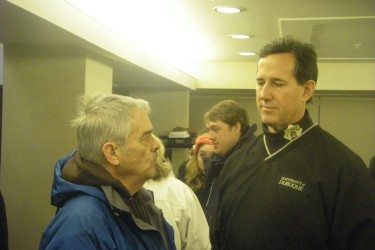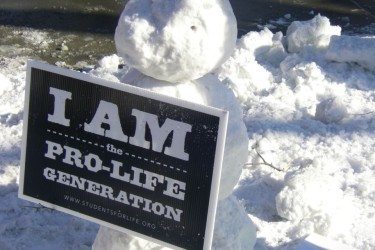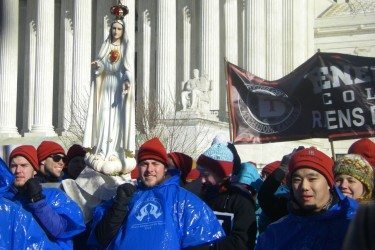Fetal Rosaries, Our Lady of Fatima, and the Spanish Inquisition: Welcome to the 2014 March for Life
The March for Life, the yearly protest on the anniversary of Roe v. Wade, is a Catholic affair, supported by the bishops and the pope. And Republicans.
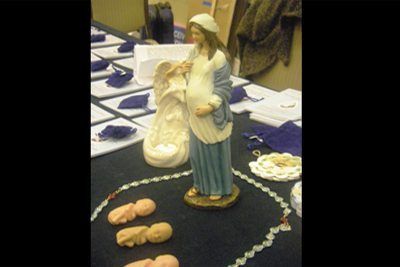
In a windowless room in a Washington hotel, a religious summit of sorts is taking place. The protesters who make an annual pilgrimage to the nation’s capital for the March for Life have gathered to “meet and greet” the very Catholic Rick Santorum, father of seven, and the very Protestant Jim Bob Duggar, father of 19.
What unites the two is a simple belief: that a woman should be willing to break her body in childbirth for the sake of bearing as many children as possible.
The march is an annual protest, held on the anniversary of the Supreme Court decision Roe v. Wade, which legalized abortion, making it the perfect platform for Santorum, the former contender for the Republican presidential nomination whose signature issue is his no-exceptions opposition to abortion, even if he is better known for his views on gay sex. (Santorum also opposes contraception.)
In one corner, several children and young people converse with the older two Santorum girls; across the room Jim Bob Duggar, star of the TLC reality show 19 Kids and Counting, is talking with an elderly couple from Wisconsin, cheering the 2013 passage of that state’s forced ultrasound law, which he calls “the heartbeat bill” for its requirement that technicians performing the medically unnecessary ultrasound mandated by the law for women seeking abortions also “provide a means for the pregnant woman to visualize any fetal heartbeat.” His wife, Michelle, is chatting up another couple.
As Santorum makes his way toward the door, an older man approaches to ask the former U.S. senator from Pennsylvania if he’ll be running for the GOP presidential nomination in 2016, as he did in 2012. “I’m thinking about it,” Santorum replies with a smile.
* * *
The meeting room areas of the Hyatt Regency Washington on Capitol Hill, which served as home base for the March for Life activists, have all the charm of an underground bunker. Down the escalator from the room where the Santorum-Duggar meet-and-greet took place, exhibits by anti-choice groups, all with a distinctly religious flavor, occupied a drab conference space in the building’s basement.
Crossing the threshold into the exhibition hall was like entering a time warp into Catholic culture as it existed before the modernization attempted by the Second Vatican Council in the 1960s. There were booths staffed by nuns in habits—the medieval dress abandoned by most orders after Vatican II—and one staffed by robed monks.
Ubiquitous among the give-away trinkets that graced exhibit tables were plastic rosary beads. And everywhere, there were images of Mary, mother of Jesus, in her many incarnations. Human Life International favored Our Lady of Czestochowa, otherwise known as the Black Madonna, depicted in the famous icon as a dark-skinned woman with a dark-skinned baby. Our Lady of Guadalupe is another popular image among the anti-choice Catholics who dominate the March for Life scene. The monks used a Madonna image as the logo of their Cafe 4 Mama, “the pro-life coffee.”
At the table for Archangel Gabriel Enterprises Inc., staffed by a middle-aged Black man (one of very few Black people among the March for Lifers), a statuette of a Mary-like white woman was styled as a kind of hipster teenage mom, her veil replaced with a floppy white beret, her customary blue-and white robes reinterpreted as a loose tunic-and-vest ensemble. But what really set her apart from standard images of the Blessed Mother was her big, pregnant belly, complete with protruding navel. Surrounding her was a set of blue glass rosary beads. Each bead, said the man staffing the booth, was to represent a tear, and inside each “tear” was the image of a fetus, rendered in gold-colored metal. The set could be had for $20. Laid out within the circle formed by the beads were three small models of beige-colored fetuses.
Here was the fundamental difference between the pre-Vatican II church and the right-wing Catholic cults of today: In the old days, such a graphic depiction of a pregnant Mary would be unthinkable, and fetal imagery was absent from religious paraphanalia. Before women had access to birth control and the legal right to abortion, such explicit depictions were unnecessary as objects of veneration. Church and state were in agreement on the limits of a woman’s freedom.
Then, with the rise of the women’s movement, state betrayed the patriarchy, first with the Supreme Court decision in Griswold v. Connecticut in 1965, which guaranteed a right to birth control, and then in 1973, with Roe v. Wade. The patriarchy responded with all the elegance of an abusive husband.
For respite from the fetuses and madonnas, I visited a booth whose materials featured slick and appealing graphics, devoid of developing embryos or religious regalia. “Save the Storks,” read the backdrop behind the table. “Are you saving actual birds?” I asked of the young white woman who staffed it. “No,” she said, laughing. The organization, she said, provides vans equipped with state-of-the-art ultrasound equipment that “can be parked right outside Planned Parenthood clinics.” The vans are painted in cheerful shades of blue and pink, some with the slogan, “You Have Options!”
Next to Save the Storks was a booth staffed by nuns, a display rife with religious trinkets and literature. An enormous tapestry of Our Lady of Guadalupe provided their backdrop. I plunked down $5 for a sticker book, Saints for Girls. I don’t know why. Most of them, naturally, met terrible fates.
Near the table that displayed “A Window to the Womb: 4D Ultrasound Images,” was a booth for Tradition, Family and Property (TFP), an organization born in 1960 of the backlash to land reform in Brazil, whose founder, Plinio Corrêa de Oliveira, described the Spanish Inquisition as “a glorious moment” for the Roman Catholic Church. TFP, which was also allied with the Pinochet regime in Chile and made common cause with the leaders of apartheid South Africa, is an all-male organization that trains young men in medieval combat.
* * *
As the marchers made their way to the National Mall on a sunny, frigid day with windchills below zero degrees, the streets seemed flooded with the green-and-white signs doled out by the Knights of Columbus stamped with black block letters reading “Defend Life.”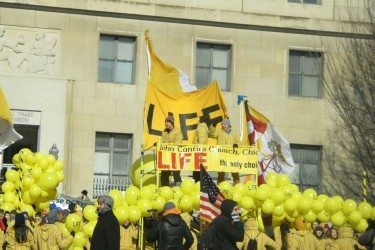
Several women drifted by with pink signs. One read “Conceived From Rape: I Love My Life.” An analog version read “Mother From Rape: I Love My Child.”
Young people were everywhere, recruited from Catholic colleges and high schools. Many carried signs that read “I Am the Pro-Life Generation.”
About a block from where a rally was staged on the National Mall as the kick-off event for the march, which would culminate at the Supreme Court, was a makeshift platform festooned with yellow balloons and flanked with yellow-and-white papal flags. Three young men in matching, hippie-style, hand-woven hoodies chanted anti-choice slogans, while a drum corps below, wearing the same outfit, performed in response. A big, yellow banner behind them simply read “LIFE.” It was as if the young people figured Pope Francis was just kidding when he urged the church to lighten its emphasis on opposition to abortion and LGBT rights. Surely they took heart from his shout-out, via Twitter, to March for Life activists earlier in the day.
The display was clearly influenced by the protests of the Occupy movement, yet interpreted, without irony, in a framework of uniformity and precision.
Three vans from Save the Storks were parked across the street.
Groups carrying wide banners represented Catholic dioceses and archdioceses from across the nation: St. Augustine, Chicago, Kansas City, Omaha, Newark, and more. Along the route, the red standards of TFP flailed in the stiff winds.
One man carried a large photograph of Duck Dynasty patriarch Phil Robertson, inscribed with this quote from the right’s favorite victim: “You have a God-given right to live! And, of all places, inside your mother. What in the world happened to us?”
As marchers assembled in front of a large stage erected on the Mall, a military-style chant was roared by a group of young men. I didn’t catch the first part, but the second half went: “Nothing finer in the land than an Irish Catholic pro-life man.”
The crowd of thousands stood patiently, listening to speakers for an hour in temperatures that barely broke into the double-digits. March for Life President Jeanne Monahan read the pope’s tweeted message to the crowd. House Majority Leader Eric Cantor (R-VA) promised a vote on the House floor next week for HR 7, a sweeping anti-choice bill. Rep. Chris Smith (R-NJ) stepped up to accuse President Obama of promoting “abortion violence.”
The theme of this year’s march was adoption, said Monahan, and Rep. Vicky Hartzler (R-MO) was on-message, saying that since there weren’t enough babies available for adoption, every unexpected pregnancy should be brought to term. (See Rewire’s report on the rally, here.)
By the time a youth activist who organized her high school homecoming event around the issue of “adoption, not abortion” came to the podium, I calculated that my toes had been numb for at least 20 minutes, so I briefly sought warmth in a nearby McDonalds, then headed for the subway, figuring to meet the marchers at their final destination, the Supreme Court.
By the time I hiked from Union Station to the Court building, they had already arrived. The street in front of the Court was filled with banner-bearing and sign-carrying marchers, the sidewalk clogged with anti-choicers holding ad hoc prayer vigils. In front of the Court, marchers held a large banner that read “We Are Abortion Abolitionists.”
A young woman and a young man, who looked to be of high school age, built a small snowman, and affixed a “Pro-Life Generation” sign to it. Another young woman had a friend snap her photo with an iPhone as she jumped up, both heels to one side, holding the same sign.
A group of six or so young men in blue plastic ponchos parted the crowd as they walked toward the steps of the Court bearing a statue of Our Lady of Fatima on a platform that rested on their shoulders, quickly drawing a gathering around them of people praying the Apostles’ Creed. The appearance of the Blessed Mother to three schoolchildren in Fatima, Portugal, in 1917, is a favorite of anti-communists, as the children said she called for the consecration of Russia.
The windchill was said to be -2 degrees Fahrenheit. Three hours after the kick-off rally began, the anti-choice activists were still out in force.

